Page 35 of 304
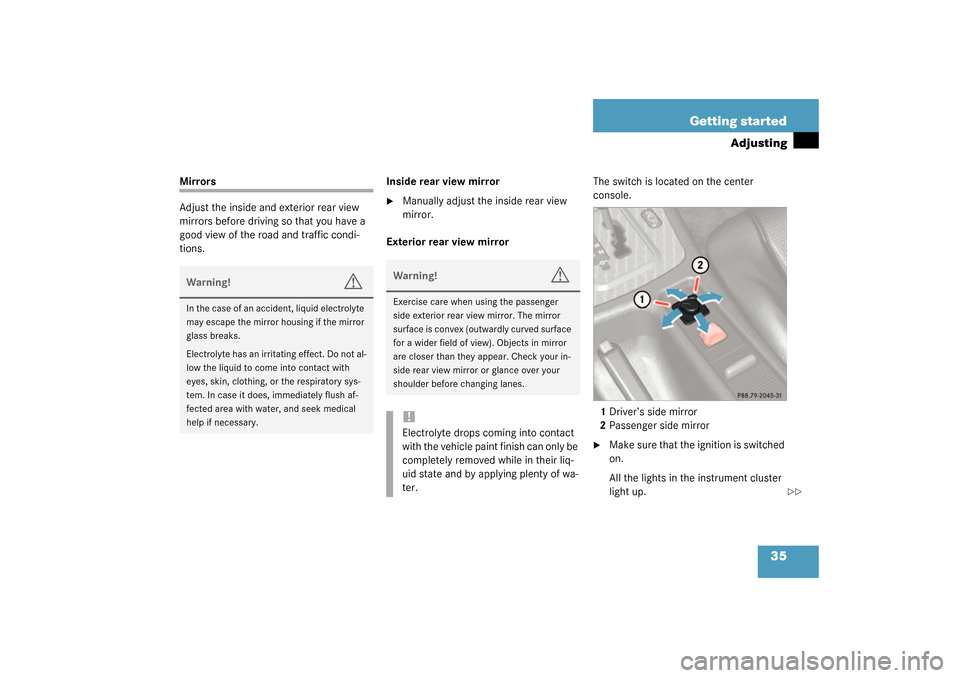
35 Getting started
Adjusting
Mirrors
Adjust the inside and exterior rear view
mirrors before driving so that you have a
good view of the road and traffic condi-
tions.Inside rear view mirror
�
Manually adjust the inside rear view
mirror.
Exterior rear view mirrorThe switch is located on the center
console.
1Driver’s side mirror
2Passenger side mirror
�
Make sure that the ignition is switched
on.
All the lights in the instrument cluster
light up.
Warning!
G
In the case of an accident, liquid electrolyte
may escape the mirror housing if the mirror
glass breaks.
Electrolyte has an irritating effect. Do not al-
low the liquid to come into contact with
eyes, skin, clothing, or the respiratory sys-
tem. In case it does, immediately flush af-
fected area with water, and seek medical
help if necessary.
Warning!
G
Exercise care when using the passenger
side exterior rear view mirror. The mirror
surface is convex (outwardly curved surface
for a wider field of view). Objects in mirror
are closer than they appear. Check your in-
side rear view mirror or glance over your
shoulder before changing lanes. !Electrolyte drops coming into contact
with the vehicle paint finish can only be
completely removed while in their liq-
uid state and by applying plenty of wa-
ter.
��
Page 42 of 304

42 Getting startedDrivingParking brake
1Brake lever
2Release button
�
Pull up slightly on brake lever1 and
press release button2.
Return brake lever1 down to its origi-
nal position.
The indicator lamp
;
(USA only)
or
3
(Canada only) in the instru-
ment cluster goes out.
Driving
�
Depress the brake pedal.
�
Move selector lever to positionD orR
(manual transmission: first or reverse
gear)
�
Release the brake pedal.
�
Carefully depress the accelerator
pedal.
Once the vehicle is in motion, the auto-
matic central locking system engages
and the locking knobs drop down.After a cold start, the automatic transmis-
sion engages at a higher revolution. This al-
lows the catalytic converter to reach its
operating temperature earlier.
Warning!
G
When leaving the vehicle always remove the
key from the steering lock and lock the vehi-
cle. Do not leave children unattended in the
vehicle, or with access to an unlocked vehi-
cle. Children could release the parking
brake, which could result in an accident or
serious injury.
iYou can open a locked door from the
inside. Open door only when conditions
are safe to do so.!If you hear a warning signal when driv-
ing off, you have forgotten to release
the parking brake.
Release the parking brake.iVehicles with automatic transmission:
Wait for the gear selection process to
complete before setting the vehicle in
motion.
Page 44 of 304
44 Getting startedDrivingHigh beam�
Push the combination switch forward.
The high beam symbol
A
in the
instrument cluster lights up.
More information can be found in the
“Controls in detail” section (
�page 85).
Windshield wipers
The combination switch is on the left of the
steering column.Combination switch1Switching on windshield wipers
2Single wipe�
Make sure that the ignition is switched
on.Switching on windshield wipers
�
Turn the combination switch to the de-
sired position depending on the inten-
sity of the rain.
0Windshield wipers off
IIntermittent wiping
IINormal wiper speed
IIIFast wiper speed
iTo signal minor directional changes,
move combination switch to point of
resistance only and release. The turn
signal blinks three times.
iFast wiper speedIII goes to settingII
when the vehicle is standing still.
Page 52 of 304
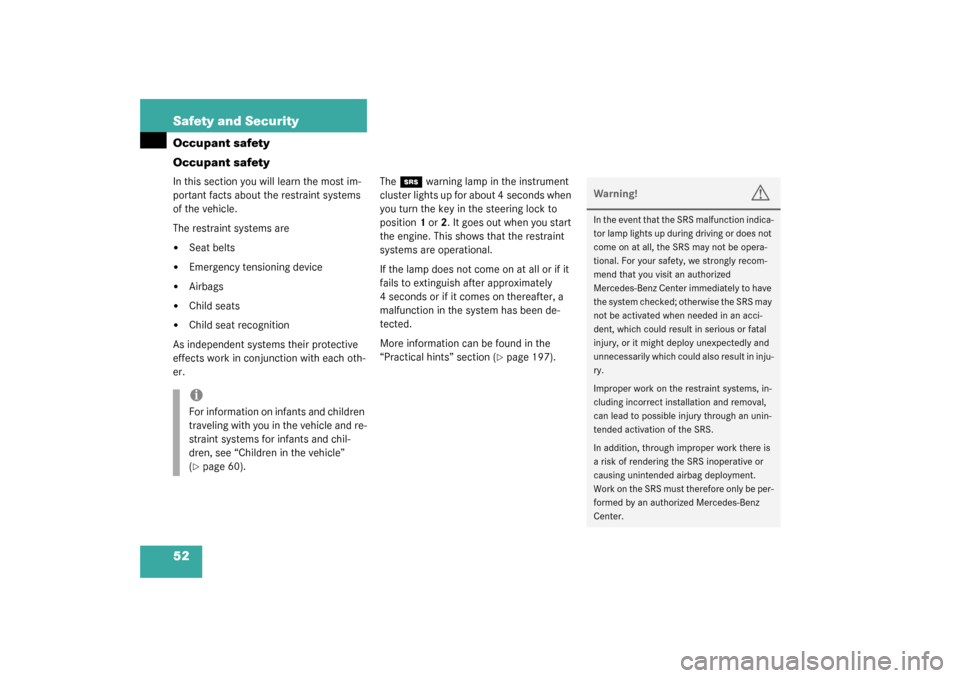
52 Safety and SecurityOccupant safety
Occupant safetyIn this section you will learn the most im-
portant facts about the restraint systems
of the vehicle.
The restraint systems are�
Seat belts
�
Emergency tensioning device
�
Airbags
�
Child seats
�
Child seat recognition
As independent systems their protective
effects work in conjunction with each oth-
er.The
1
warning lamp in the instrument
cluster lights up for about 4 seconds when
you turn the key in the steering lock to
position1 or2. It goes out when you start
the engine. This shows that the restraint
systems are operational.
If the lamp does not come on at all or if it
fails to extinguish after approximately
4 seconds or if it comes on thereafter, a
malfunction in the system has been de-
tected.
More information can be found in the
“Practical hints” section (
�page 197).
iFor information on infants and children
traveling with you in the vehicle and re-
straint systems for infants and chil-
dren, see “Children in the vehicle”
(�page 60).
Warning!
G
In the event that the SRS malfunction indica-
tor lamp lights up during driving or does not
come on at all, the SRS may not be opera-
tional. For your safety, we strongly recom-
mend that you visit an authorized
Mercedes-Benz Center immediately to have
the system checked; otherwise the SRS may
not be activated when needed in an acci-
dent, which could result in serious or fatal
injury, or it might deploy unexpectedly and
unnecessarily which could also result in inju-
ry.
Improper work on the restraint systems, in-
cluding incorrect installation and removal,
can lead to possible injury through an unin-
tended activation of the SRS.
In addition, through improper work there is
a risk of rendering the SRS inoperative or
causing unintended airbag deployment.
Work on the SRS must therefore only be per-
formed by an authorized Mercedes-Benz
Center.
Page 57 of 304
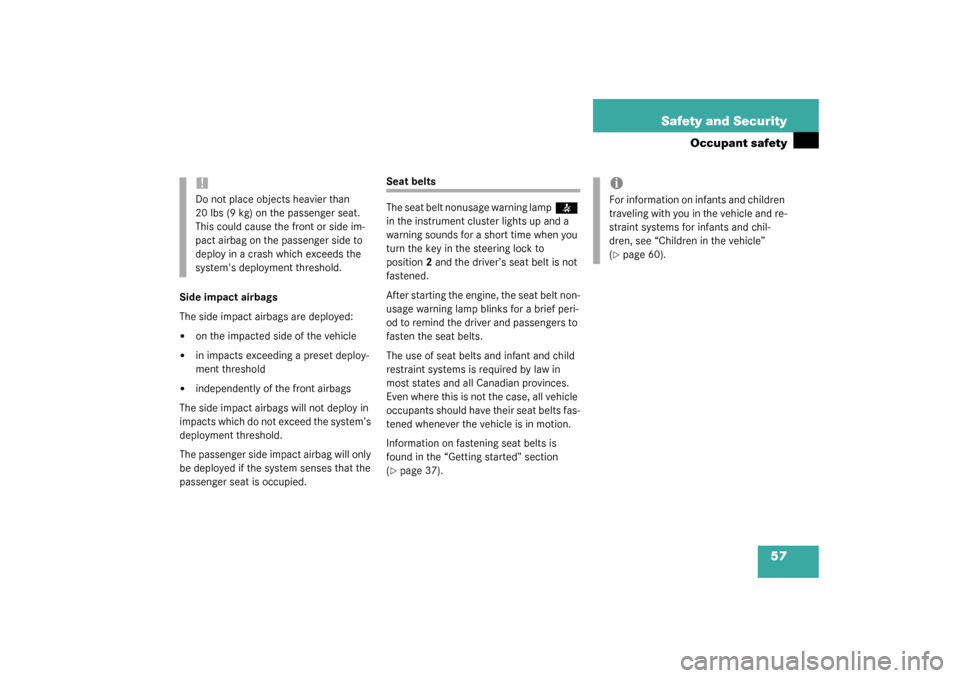
57 Safety and Security
Occupant safety
Side impact airbags
The side impact airbags are deployed:�
on the impacted side of the vehicle
�
in impacts exceeding a preset deploy-
ment threshold
�
independently of the front airbags
The side impact airbags will not deploy in
impacts which do not exceed the system’s
deployment threshold.
The passenger side impact airbag will only
be deployed if the system senses that the
passenger seat is occupied.
Seat belts
The seat belt nonusage warning lamp
<
in the instrument cluster lights up and a
warning sounds for a short time when you
turn the key in the steering lock to
position2 and the driver’s seat belt is not
fastened.
After starting the engine, the seat belt non-
usage warning lamp blinks for a brief peri-
od to remind the driver and passengers to
fasten the seat belts.
The use of seat belts and infant and child
restraint systems is required by law in
most states and all Canadian provinces.
Even where this is not the case, all vehicle
occupants should have their seat belts fas-
tened whenever the vehicle is in motion.
Information on fastening seat belts is
found in the “Getting started” section
(
�page 37).
!Do not place objects heavier than
20 lbs (9 kg) on the passenger seat.
This could cause the front or side im-
pact airbag on the passenger side to
deploy in a crash which exceeds the
system's deployment threshold.
iFor information on infants and children
traveling with you in the vehicle and re-
straint systems for infants and chil-
dren, see “Children in the vehicle”
(�page 60).
Page 63 of 304
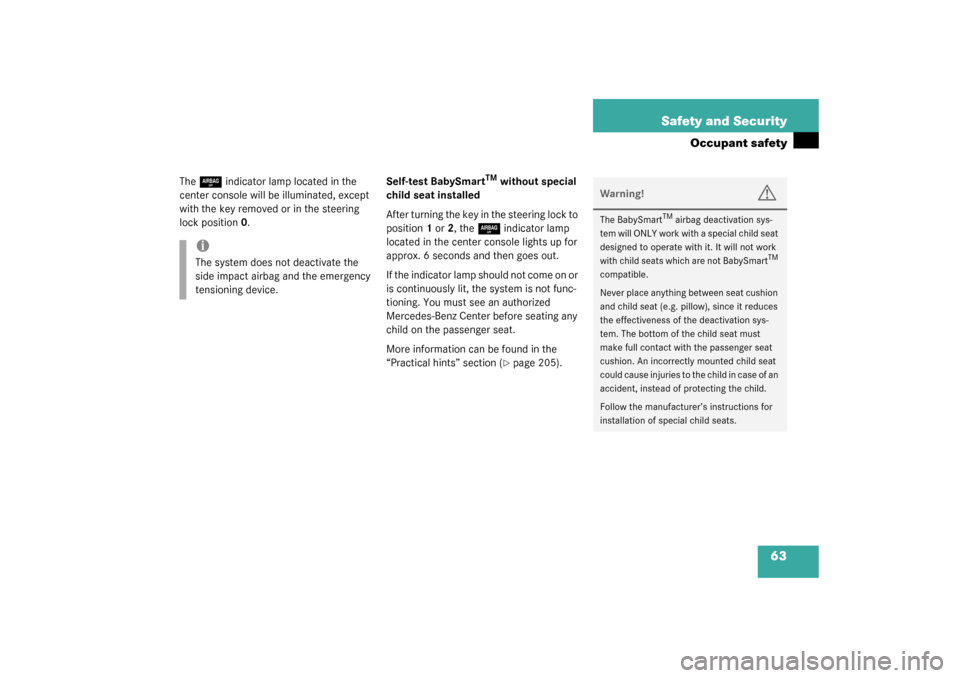
63 Safety and Security
Occupant safety
The
7
indicator lamp located in the
center console will be illuminated, except
with the key removed or in the steering
lock position0.Self-test BabySmart
TM
without special
child seat installed
After turning the key in the steering lock to
position1 or2, the
7
indicator lamp
located in the center console lights up for
approx. 6 seconds and then goes out.
If the indicator lamp should not come on or
is continuously lit, the system is not func-
tioning. You must see an authorized
Mercedes-Benz Center before seating any
child on the passenger seat.
More information can be found in the
“Practical hints” section (�page 205).
iThe system does not deactivate the
side impact airbag and the emergency
tensioning device.
Warning!
G
The BabySmart
TM airbag deactivation sys-
tem will ONLY work with a special child seat
designed to operate with it. It will not work
with child seats which are not BabySmart
TM
compatible.
Never place anything between seat cushion
and child seat (e.g. pillow), since it reduces
the effectiveness of the deactivation sys-
tem. The bottom of the child seat must
make full contact with the passenger seat
cushion. An incorrectly mounted child seat
could cause injuries to the child in case of an
accident, instead of protecting the child.
Follow the manufacturer’s instructions for
installation of special child seats.
Page 64 of 304
64 Safety and SecurityOccupant safetyWarning!
G
When using a BabySmart
TM compatible
child seat on the passenger seat, the front
passenger airbag will not deploy only if
the
7
indicator lamp remains illuminat-
ed.
Please be sure to check the indicator every
time you use the special system child seat.
Should the light go out while the restraint is
installed, please check installation. If the
light remains out, do not use the
BabySmartTM restraint to transport children
on the passenger seat until the system has
been repaired.
Warning!
G
Do not place powered-on laptops, cell
phones and like electronic devices on the
passenger seat. Signals from such devices
may interfere with the BabySmart
TM system.
Such signal interference may cause
the
7
indicator lamp not to come on
during self-test or be continuously lit, indi-
cating that the system is not functioning.
Page 66 of 304
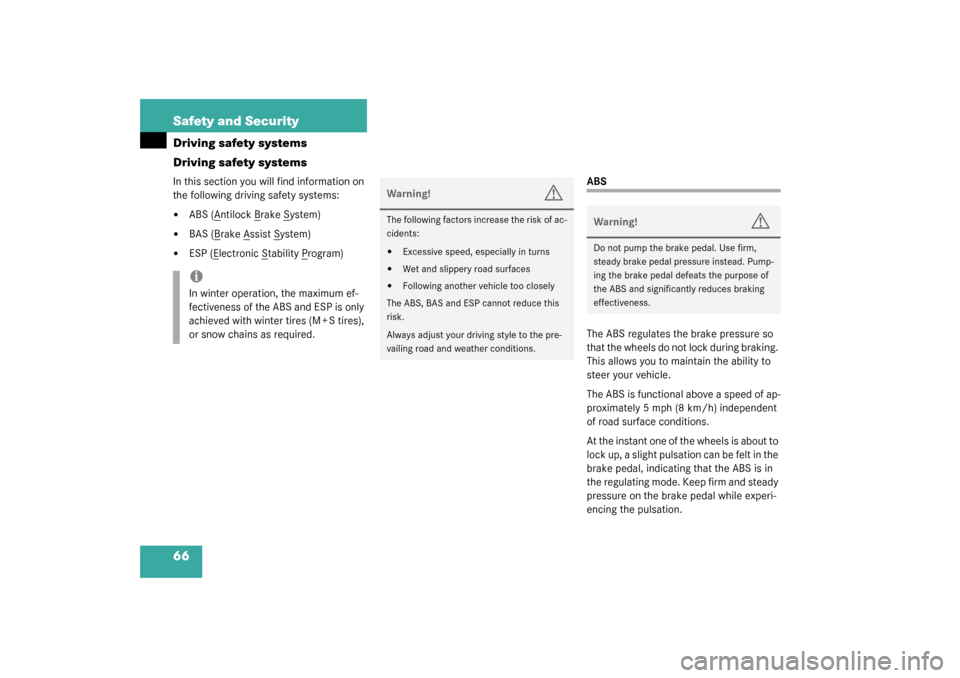
66 Safety and SecurityDriving safety systems
Driving safety systemsIn this section you will find information on
the following driving safety systems:�
ABS (A
ntilock B
rake S
ystem)
�
BAS (B
rake A
ssist S
ystem)
�
ESP (E
lectronic S
tability P
rogram)
ABS
The ABS regulates the brake pressure so
that the wheels do not lock during braking.
This allows you to maintain the ability to
steer your vehicle.
The ABS is functional above a speed of ap-
proximately 5 mph (8 km/h) independent
of road surface conditions.
At the instant one of the wheels is about to
lock up, a slight pulsation can be felt in the
brake pedal, indicating that the ABS is in
the regulating mode. Keep firm and steady
pressure on the brake pedal while experi-
encing the pulsation.
iIn winter operation, the maximum ef-
fectiveness of the ABS and ESP is only
achieved with winter tires (M + S tires),
or snow chains as required.
Warning!
G
The following factors increase the risk of ac-
cidents:�
Excessive speed, especially in turns
�
Wet and slippery road surfaces
�
Following another vehicle too closely
The ABS, BAS and ESP cannot reduce this
risk.
Always adjust your driving style to the pre-
vailing road and weather conditions.
Warning!
G
Do not pump the brake pedal. Use firm,
steady brake pedal pressure instead. Pump-
ing the brake pedal defeats the purpose of
the ABS and significantly reduces braking
effectiveness.